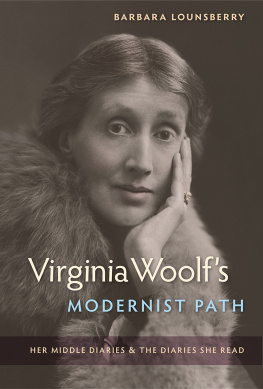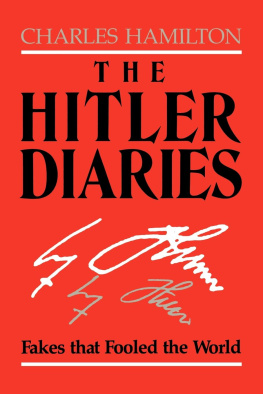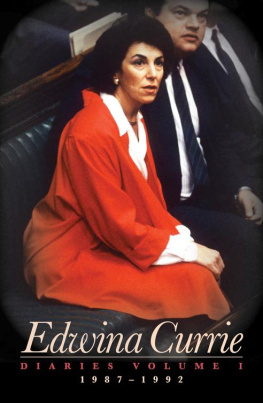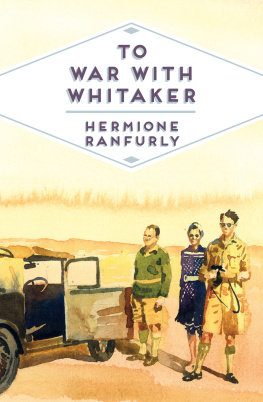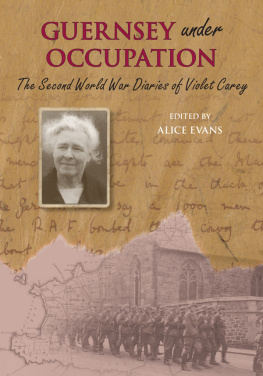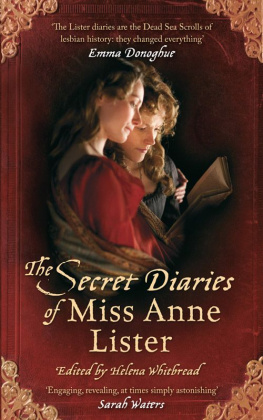
Virginia Woolfs Modernist Path
UNIVERSITY PRESS OF FLORIDA
Florida A&M University, Tallahassee
Florida Atlantic University, Boca Raton
Florida Gulf Coast University, Ft. Myers
Florida International University, Miami
Florida State University, Tallahassee
New College of Florida, Sarasota
University of Central Florida, Orlando
University of Florida, Gainesville
University of North Florida, Jacksonville
University of South Florida, Tampa
University of West Florida, Pensacola
Virginia Woolfs
MODERNIST PATH
Her Middle Diaries & the Diaries She Read
Barbara Lounsberry
UNIVERSITY PRESS OF FLORIDA
Gainesville/Tallahassee/Tampa/Boca Raton
Pensacola/Orlando/Miami/Jacksonville/Ft. Myers/Sarasota
.
Copyright 2016 by Barbara Lounsberry
All rights reserved
Printed in the United States of America on acid-free paper
This book may be available in an electronic edition.
First cloth printing, 2016
First paperback printing, 2019
24 23 22 21 20 19 6 5 4 3 2 1
LIBRARY OF CONGRESS CATALOGING-IN-PUBLICATION DATA
Names: Lounsberry, Barbara, author.
Title: Virginia Woolfs modernist path : her middle diaries and the diaries she read / Barbara Lounsberry.
Description: Gainesville : University Press of Florida, 2016. | Includes bibliographical references and index.
Identifiers: LCCN 2016027491 | ISBN 9780813062952 (cloth) ISBN 9780813064307 (pbk.)
Subjects: LCSH: Woolf, Virginia, 1882-1941Diaries. | Novelists, English20th centuryDiaries.
Classification: LCC PR6045.O72 Z8119 2016 | DDC 828/.91203 [B] dc23
LC record available at https://lccn.loc.gov/2016027491
The University Press of Florida is the scholarly publishing agency for the State University System of Florida, comprising Florida A&M University, Florida Atlantic University, Florida Gulf Coast University, Florida International University, Florida State University, New College of Florida, University of Central Florida, University of Florida, University of North Florida, University of South Florida, and University of West Florida.
UNIVERSITY PRESS OF FLORIDA
2046 NE Waldo Road
Suite 2100
Gainesville, FL 32609
http://upress.ufl.edu
For Sam, the writer, and Madeline, the painter
Contents
Acknowledgments
First thanks go to poet Kathleen Kelly and to editor Shannon McCarthy, who named this volume and whose thoughtful questions led to this projects shape. Novelist and poet Nancy Price also lent her ear and practiced eye to the refinement and polish of the work. My gratitude goes as well to Woolf scholars Panthea Reid and Mark Hussey, who each read two drafts of the book and offered suggestions that strengthened and enriched it immeasurably.
My eternal thanks go as well to those in England directly involved with the editing and publishing of Woolfs luminous diaries. Anne Olivier Bell, the accomplished and witty editor of Woolfs 1915 to 1941 diaries, allowed me to interview her in Sussex regarding her work and graciously served me lunch on the long wood table where much of the editing unfurled. Quentin Bell, before his death, fully and promptly answered all my letter questions regarding his Aunt Virginia and her diaries.
Andrew McNeillie, assistant editor of the 1920 to 1941 diaries, took time from the 2001 Woolf Conference in Wales to recall and reflect on his work.
In England, Sybil Oldfield, the Woolf scholar, kindly gave over a whole Sunday afternoon to take me to Monks House and to the nearby bridge over the River Ouse. I am indebted as well to Dorothy Sheridan, head of Special Collections at the University of Sussex, for allowing me to work with the Monks House papers.
Over a score of years, the curators of the Henry W. and Albert A. Berg Collection of English and American Literature in the New York Public Library have also shared their expertise during my hours of work with Woolfs manuscripts. This access was vital. I wish also to thank the International Virginia Woolf Society, whose members are so welcoming of papers and essays.
My gratitude extends as well to many arms of the University of Northern Iowa. The Graduate College and the College of Humanities and Fine Arts provided grants and leaves that allowed this work to grow. Especial thanks go to Rosemary Meany and others in the Rod Library who helped me locate and retrieve many of the obscure diaries Woolf read.
Abbreviations
CR | The Common Reader. 2 vols. |
D | The Diary of Virginia Woolf. Ed. Anne Olivier Bell. 5 vols. |
E | The Essays of Virginia Woolf. Ed. Andrew McNeillie and Stuart N. Clarke. 6 vols. |
L | The Letters of Virginia Woolf. Ed. Nigel Nicolson and Joanne Trautmann. 6 vols. |
MOB | Moments of Being. Ed. Jeanne Schulkind. |
PA | A Passionate Apprentice: The Early Journals, 18971909. Ed. Mitchell A. Leaska. |
ROO | A Room of Ones Own |
RN | Virginia Woolfs Reading Notebooks. Ed. Brenda Silver. |
SF | The Complete Shorter Fiction of Virginia Woolf. Ed. Susan Dick |
TG | Three Guineas |
Introduction
A diary is not only a text: it isa way of life, of which the text is merely a trace or by-product.
So says French diary theorist Philippe Lejeune (268). By July 1918, diary-keeping has become a way of life for Virginia Woolf. She started as an early teen, trying to keep a daily journal in a small, brown, leather diary with a lock and key. The year was 1897. Thirty-seven handwritten diary books follow across her daysuntil four days before her suicide in March 1941. These books are the doorway to her fiction and nonfiction. They also show Woolf to be one of the worlds great diarists, in fact, the Shakespeare of the diary, as diary scholar Anna Jackson dares to suggest (Diary Poetics 151).
Woolfs first twelve diary books are strikingly experimental. Not one resembles another. In these first dozen journals (covering ages fourteen through thirty-six), Woolf tries travel diaries, a natural history diary, diaries with titled entries and book-like tables of contentsand even an occasional life diary. This experimental first diary stage leads to the years 1917 and 1918: Woolfs most intensive years of diary-writing. She keeps two diaries now, a country diary and a city diary, and writes in both diaries on seventeen days. Has any other diarist done this?
In July 1918as my volume opensshe brings her city diary to the country, a telling move. Within four months the country diary fuses with the city diary, creating the ideal Country in London state Woolf first envisioned at age twenty-one in her pivotal 1903 diary. The country, for Woolf, stands for nature, the unconscious, and the female, while the city embodies culture, the conscious mind, and the male (PA 17779). These domains join. A crisis occurs in November 1918 that leads to a new audience and purpose for the diary, and with it the start of Woolfs second stage as a diarist: her mature, spare modernist period, 1918 to 1929. Woolfs own crisis mirrors what Pericles Lewis calls the crisis of
Next page
